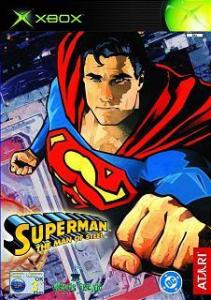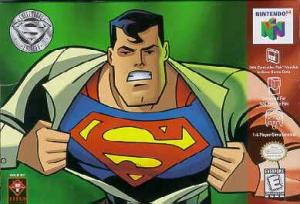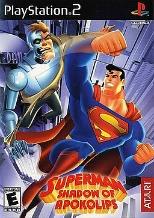Video games have not been kind to the Man of Steel. There are over a dozen games starring Superman that have been released, and the best one, Superman: Shadow of Apokolips, rests at a 64 on Metacritic. Lets not also forget that Superman also is the subject of much ridicule in the video game world, having starred in one of the worst and infamously bad games of all time, Titus’ Superman 64. This stands from a stark contrast to DC’s other famous hero, Batman, who while having a few stinkers to his name like Batman Beyond: Return of the Joker and Batman: Dark Tomorrow, has found tremendous success in the video game market over the past couple of years thank to Rocksteady and the Arkham franchise.
Despite the many failures that have plagued Superman’s many attempts at a video game franchise, there’s still a lot of good lessons that developers of any future Superman game can learn where other’s have failed in the past. Though most Superman games have ranged from only pretty good to flat-out terrible, most have some redeeming qualities that should be looked at for anyone attempting to bring the hero back to the video game space, something I always hope will happen. Superman has been an icon for close to a century because he is a timeless character and there’s no reason why those who love video games and the character should have to look at his interactive history with so much disdain.
I’m not going to pick an element of all the Superman games that people can learn from, because to be honest, there are games like Superman on the Game Boy and Superman Returns: Fortress of Solitude that deserve to be forgotten. What I’ll be doing instead is looking at various things, like controls, mechanics, story and presentation, and how past Superman games have done those things better than anyone who has worked on the character before.
CONTROLS
BEST EXAMPLE: SUPERMAN: THE MAN OF STEEL (XBOX ORIGINAL)
Superman has a lot of powers and abilities: flight, super speed, freeze breath as well as heat and X-ray vision. Juggling all of these on a controller without becoming clumsy or too complicated is a very difficult task, but for all it’s problems, Superman: The Man of Steel on the original Xbox showed how easy it is to balance all of these abilities. Each face button corresponded to an offensive ability: punching, freeze breath and heat vision, while support abilities like X-ray vision were moved down to the black and white buttons. This meant that special focus was given to offensive powers that the player would be using most while abilities like X-Ray vision that are not used that much were moved downwards from the four main face buttons. What made this rather simplified system even easier to wrap the player’s head around was the way the enemies were designed. Each enemy was colour coordinated a certain way such that you knew what power to be using. A yellow enemy, for example, had to be punched, while one who was purple in colour had to taken out with heat vision. This also meant that one power or ability wasn’t used over another, such as in the case of Superman: Countdown to Apokolips on the Game Boy Advance that gave no repercussions for spamming your heat vision.
HEALTH
BEST EXAMPLE(S): SUPERMAN 64 AND SUPERMAN RETURNS
Okay, before you start saying “Huh?! Nothing good came from Superman 64!!!”, just hear me out. Quite possibly the biggest hurdle all developers have had to overcome with the subject of Superman is his nigh-invulnerability. How exactly do you make a game about a guy who can’t get hurt, and at the same time craft one that’s both challenging as well as true to the character?
This brings me as to why I bring up Superman 64 here. That game had an insane plot about Lex Luthor trapping Superman’s friends in a virtual reality version of Metropolis, thus forcing Superman to enter the faux-Metropolis to foil Luthor’s plans and recover his friends. As dumb as the plot is though, at least it’s an attempt, albeit a very flimsy one, to say why Superman can die from bullets fired by random thugs on the street without saying something equally as outlandish is all the bullets in all the clips are lined with Kryptonite. Contrast this to a game I placed number two when ranking Superman games, Sunsoft’s The Death and Return of Superman, which had thugs with chain saws who could hurt Superman with the only reason being given as “because video game”.
A better, more plausible, way to do damage right in a video game was 2006’s Superman Returns. In that game, Superman was invulnerable, however the game’s health meter was indicated by the damage being done to the city of Metropolis. The more damage that was done to the city, either by crime or natural disasters, the more the city’s “health” dropped and if it fell far enough, it meant game over. For all the bad that game did, like having the final boss as a tornado, it did that one thing very, very well. There has not been a published console Superman game since that title, but I believe that if one is considered going forward, this is a concept that should definitely be utilized once again.
ART DIRECTION AND PRESENTATION
BEST EXAMPLE: SUPERMAN: SHADOW OF APOKOLIPS
Superman: Shadow of Apokolips is my favourite Superman game that has ever been released, and one of the main reasons why I love that game so much is its gorgeous, cel-shaded graphics. Superman, I strongly feel, is a character that shouldn’t have a muted colour palette, and game makers should not be ashamed to embrace a more bright, optimistic art style. And yes, this is a stab at Zack Snyder’s desire to substitute red’s and blue’s for maroon’s and navy’s.
What also made playing Apokolips so much fun despite its flaws is that it brought back actors from the 90’s Superman animated series, including Tim Daly as the title character. One of Rocksteady’s claim to fame with the Arkham series was bringing back Kevin Conroy and Mark Hamill as Batman and the Joker respectively, so why not do the same for a Superman game? Recently you can look to 2013’s Injustice: Gods Among Us as an example of WB Games hiring a past Superman when actor George Newbern, who replaced Tim Daly as Superman in Justice League as well as Justice League: Unlimited, played the character against Kevin Conroy who also voiced Batman in that game as well.
FLIGHT
BEST EXAMPLE: SUPERMAN RETURNS
Superman: The Man of Steel had the best controls for a Superman game when it came to combat and super powers, but where it lacked polish was in flight. You never once got the sense of speed that is associated with moving “faster than a speeding bullet”. That was one of the strong points of EA’s Superman Returns. When picking up speed, you could hear a sonic boom behind you with an appropriate corresponding rumble coming from the controller. Whoever makes the next Superman game would be wise to marry the flight controls from returns, with the combat mechanics of The Man of Steel.
What Superman Returns did right when it came to flight was also the area in which you fly around in as well. Previous Superman games all had structured levels but Returns was the first to set the character in a fully realized open world where the player was free to just fly around or help citizens in need. This, above all else, is what a Superman game should have a lot of. Superman does have a huge rogues gallery of villains, but it’s really flying around and reacting to crime and disasters, helping the common man, that makes the character who he is. A problem with Returns is that thee simply wasn’t enough to do from moment to moment, but it was a great way to portray a day in the life of Superman.
STORY
BEST EXAMPLE: THE DEATH AND RETURN OF SUPERMAN
With the exception of some old PC, Atari and discontinued iOS games, I’ve played every game starring Superman. If pressed to tell you what the story of any of the games, I couldn’t tell you, with the exception of one, The Death and Return of Superman, and that’s for the simple fact that it was based on the story of the same name from the comics. Any future Superman game doesn’t have to be a slave to any one comic book story like that game was, but the character’s extensive history shouldn’t exactly be ignored either. The Arkham games starting out were loosely based on an existing story with their own twist, yet they still managed to bring in elements from famous stories in Batman: Arkham Knight that I won’t spoil here for anyone who hasn’t played that game yet. If a new successful Superman franchise is started, it’s going to need its own universe, but it never hurts to build that foundation on the characters decades of stories from comics, to animation and even films.








Wow, best article I’ve read in a while, out of ALL sites i usually frequent. You sure went above and beyond with your research AND your presentation. Most people I’ve discussed this with (including myself) think no Superman game has come close to delivering a true Superman experience. For once, I enjoy being wrong. You’ve shown how each Superman game, though unsuccessful, contains elements that are great at representing some aspect of the character.
This article kinda reminds of the Batman video game discussions pre-Arkham Asylum. Everyone was sad that no game made you feel like Batman, even though each previous game had praiseworthy qualities such as stealth in Batman Begins and gadgets/voice-acting/story in Batman: Vengeance. I don’t know if Rocksteady was listening in on some of these conversations, but they managed to make their games great by marrying a great comic-inspired story with stealth elements and gadgets. Then they added some original stuff like the brilliant art style and free-flow combat (a game mechanic that has been unsuccessfully copied in several games).
Anyway, I need to stop myself now. Great work though.
LikeLiked by 1 person
Wow, best article I’ve read in a while, out of ALL sites i usually frequent. You sure went above and beyond with your research AND your presentation. Most people I’ve discussed this with (including myself) think no Superman game has come close to delivering a true Superman experience. For once, I enjoy being wrong. You’ve shown how each Superman game, though unsuccessful, contains elements that are great at representing some aspect of the character.
This article kinda reminds of the Batman video game discussions pre-Arkham Asylum. Everyone was sad that no game made you feel like Batman, even though each previous game had praiseworthy qualities such as stealth in Batman Begins and gadgets/voice-acting/story in Batman: Vengeance. I don’t know if Rocksteady was listening in on some of these conversations, but they managed to make their games great by marrying a great comic-inspired story with stealth elements and gadgets. Then they added some original stuff like the brilliant art style and free-flow combat (a game mechanic that has been unsuccessfully copied in several games).
Anyway, I need to stop myself now. Great work though.
LikeLike
Thank you. I totally agree, there were great Batman games pre-Arkham but none were really excellent. As long as it took to get Arkham though, I still think Batman’s a pretty easy character to turn into a great video game. Superman, I feel, is much, much more challenging, but the right studio could do it justice.
LikeLike
Pingback: RANKING THE SUPERMAN GAMES FROM WORST TO BEST | Comic Gamers Assemble
Pingback: DESIGN DOCUMENT: SUPERMAN | Comic Book Video Games